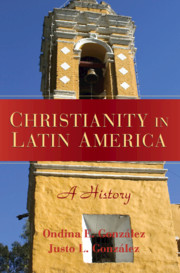Book contents
- Frontmatter
- Contents
- Preface
- Introduction
- 1 Foundations
- 2 The Arrival of Christianity
- 3 The Shaping of the Faith
- 4 Reform Movements
- 5 The Church in Turmoil
- 6 The Church's New Place
- 7 Protestant Immigration
- 8 An Expanding Protestant Presence
- 9 Catholicism after Vatican II
- 10 Pentecostalism and Autochthonous Movements
- 11 By Way of Conclusion
- Some Suggestions for Further Reading
- Sources Referenced
- Index
7 - Protestant Immigration
Published online by Cambridge University Press: 05 June 2012
- Frontmatter
- Contents
- Preface
- Introduction
- 1 Foundations
- 2 The Arrival of Christianity
- 3 The Shaping of the Faith
- 4 Reform Movements
- 5 The Church in Turmoil
- 6 The Church's New Place
- 7 Protestant Immigration
- 8 An Expanding Protestant Presence
- 9 Catholicism after Vatican II
- 10 Pentecostalism and Autochthonous Movements
- 11 By Way of Conclusion
- Some Suggestions for Further Reading
- Sources Referenced
- Index
Summary
At the same time as Spanish and Portuguese invaders were shaping and reshaping life in the western hemisphere, religion in Europe was also undergoing drastic and even convulsive changes. Hernán Cortés (1485–1547), the conqueror of Mexico, was a contemporary of Martin Luther (1483–1547). In 1521, as Cortés was engaged in the conquest of the Aztecs, supposedly on behalf of King Charles I, Luther was confronting the same ruler, under his other title, Emperor Charles V, at the Diet of Worms. The century of the Conquista is also the century of the Reformation.
The parallelism and contrast between these two events were not lost on Spanish chroniclers of the time. Later in the same century, Friar Gerónimo de Mendieta, a Franciscan missionary in Mexico, decided to write his Historia eclesiástica indiana (Church History of the Indies). There he wrote that Hernán Cortés and Martin Luther had been born on exactly the same day – which was not true – and on that basis declared that God
chose as His instrument this valiant captain, Hernán Cortés, in order to open the door and prepare the way for the preaching of His Gospel in this New World, thus compensating the Catholic Church with the conversion of many souls, and undoing the great loss and evil that would be done by accursed Martin Luther.
- Type
- Chapter
- Information
- Christianity in Latin AmericaA History, pp. 184 - 205Publisher: Cambridge University PressPrint publication year: 2007
- 1
- Cited by



